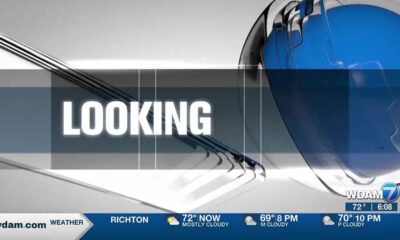Kaiser Health News
A Trans Teen No Longer Feels Welcome in Florida. So She Left.
by Stephanie Colombini, WUSF
Thu, 25 May 2023 09:00:00 +0000
For support, call Trans Lifeline at 877-565-8860 or The Trevor Project at 866-488-7386; or text to 678-678.
Josie had put off packing long enough. The high school sophomore in St. Augustine, Florida, sat on her bed while her mom, Sarah, pulled clothes from her closet.
It held a trove of good memories — like the red dress Josie wore to the winter homecoming dance and a pink cover-up she sported at a friend's pool party. Good times like these have felt scarce lately. Josie, who's transgender, no longer feels welcome in Florida.
Her family requested they be identified by their first names only, fearing retaliation in a state where Republican Gov. Ron DeSantis and other officials have proposed, politicized, and passed policies in health care and education that limit identity expression, access to certain school activities, and accommodations for trans people.
The ACLU is tracking bills it calls an “attack on LGBTQ rights, especially transgender youth.” State legislation has forced some residents like Josie to rethink where they want to call home.
Josie moved more than a thousand miles from St. Augustine — and her parents — to start a new life in Rhode Island and stay with her aunt and uncle, who live outside Providence.
Preparing her for the move, Josie's mom held up outfits and asked, “Staying or going?”
The formal dress could stay behind. Cardigans and overalls went in the suitcase. At one point, the family dog, Reesie, crawled past the luggage to snuggle up to Josie.
“She has a sense when I'm sad, and just comes running in,” said Josie, 16.
Moving to Rhode Island had been Plan B for some time, but Josie said she never thought it would happen. Much has changed in the past year.
Florida is one of more than a dozen states that have passed bans on gender-affirming medical treatments for minors, such as puberty blockers, hormone therapy, and certain surgeries.
Florida's medical boards began debating those bans last summer. For months, Josie was terrified she would lose access to hormones she takes to help her body align with her identity.
Board members argued gender-affirming treatments were “experimental” and, in March, barred doctors from prescribing them to minors. They allowed children who had already started care to continue. But Josie didn't trust that her access would last.
This spring, the legislature considered forcing all trans youth to stop treatment by Dec. 31, part of a bill to bolster restrictions on transgender care.
“I thought that they would realize what they've done wrong and repeal some things,” Josie said. “But they just kept going. It just became, like, too real, too fast.”
Lawmakers ended up stripping that provision just before the session ended this month, allowing young people like Josie to stay in treatment.
But she had already made her decision to move out of state. School has been challenging at times since Josie came out as trans in eighth grade. Some childhood friends rejected her.
Josie wanted to play on the girls tennis team, but Florida law bans trans girls and women from competing on school teams meant for athletes assigned female at birth.
She said living in Florida was also especially painful after the state passed the Parental Rights in Education law, which “prohibits classroom discussion about sexual orientation or gender identity in certain grade levels.” Critics call it the “Don't Say Gay” law and said it has had a chilling effect on some teachers. Josie noticed stickers signifying that areas were “safe spaces” for LGBTQ+ people had been taken down at school.
“Which is just ridiculous, like you want your students to be comfortable and safe,” she said.
The new laws and anti-trans rhetoric are hurting kids across Florida, said Jennifer Evans, a clinical psychologist at the University of Florida's Youth Gender Program in Gainesville.
“I'm seeing more anxiety, more depression,” Evans said. “Things I hear patients say are, ‘The government doesn't want me to exist.' They don't feel safe.”
States are pushing measures on all sorts of gender-related issues — not just health care, but what schools can teach or which bathrooms people can use.
Bills don't have to pass to cause harm, said Evans, who is queer.
“It's a lot to feel like enough people in this country don't agree with your existence — which actually isn't affecting them — that people want to shut down other people's access to living complete and affirmed lives,” she said. “It's painful to see that.”
Four families who sought care at Evans' clinic have already left Florida, she said, while another 10 plan to move this year. Some older teens she treats also want to get out when they turn 18.
But moving isn't easy for many families.
“Just financially, it's difficult to uproot what we've set up,” Josie's dad, Eric, said.
They've owned their home in St. Augustine for a long time. Eric recently started a new job. Josie's mom, Sarah, works at a private college that offers a benefit that allows Josie and her older sister to get reduced tuition at some colleges around the country.
So her parents decided that, at least for now, Josie would go live with her aunt and uncle and they would stay behind.
The choice was devastating.
“It was just terror in my heart, like you could just feel that cold burst in my chest just going all throughout my body,” said Sarah. “Josie is part of everything I do.”
Josie will finish her sophomore year in Rhode Island before returning to St. Augustine for summer break. Her family sees it as a trial run for what could be years of separation.
One night before Josie left, she invited friends over for a going-away party. The teens played a dance video game, laughing as they performed a hip-hop routine.
Sarah brought out a Black Forest cake. “We love you Josie” was piped in frosting along the platter, framed by two hearts.
It was a simple but powerful send-off from the support system Josie has relied on in Florida. A few days later, she and her mom flew north to get Josie settled. Leaving her daughter in Rhode Island was “agony,” Sarah said.
“I was a mess,” she said. “I cried the whole way to the airport. I just felt I was going the wrong way.”
Sarah is still adjusting to life without Josie at home, but they talk every day. And Josie is getting used to her new environment. Her aunt and uncle have been great, she said, and she's making friends at school.
Her new school is a little smaller than her old one and in a community that feels more liberal-minded, the family said. Josie said she loves seeing pride flags in the halls and plans to join the Gender and Sexuality Alliance Club. It all feels like a “bombardment of support.”
“It was just, like, such a shock to me — like, not a bad shock, but, like, just shocked that this is how schools can be,” Josie said. “It's just that Florida's choosing not to be like that.”
DeSantis' office did not respond to several requests for comment to address concerns of families like Josie's.
Since Josie moved to Rhode Island in April, DeSantis has signed four bills that would curb health care and gender expression of trans people.
Josie's parents said they'll keep their pride flag waving in the front yard and advocate for equality while she's away.
Josie said she thinks about the trans kids who can't leave and urged them not to give up hope. But right now, she needs to move on.
This article is from a partnership that includes WUSF, NPR, and KFF Health News.
KFF Health News is a national newsroom that produces in-depth journalism about health issues and is one of the core operating programs at KFF—an independent source of health policy research, polling, and journalism. Learn more about KFF.
USE OUR CONTENT
This story can be republished for free (details).
By: Stephanie Colombini, WUSF
Title: A Trans Teen No Longer Feels Welcome in Florida. So She Left.
Sourced From: kffhealthnews.org/news/article/a-trans-teen-no-longer-feels-welcome-in-florida-so-she-left/
Published Date: Thu, 25 May 2023 09:00:00 +0000
Did you miss our previous article…
https://www.biloxinewsevents.com/california-hospitals-seek-a-broad-bailout-but-they-dont-all-need-it/
Kaiser Health News
Oh, Dear! Baby Gear! Why Are the Manuals So Unclear?
Darius Tahir
Fri, 03 May 2024 09:00:00 +0000
Since becoming a father a few months ago, I've been nursing a grudge against something tiny, seemingly inconsequential, and often discarded: instructional manuals. Parenthood requires a lot of gadgetry to maintain a kid's health and welfare. Those gadgets require puzzling over booklets, decoding inscrutable pictographs, and wondering whether warnings can be safely ignored or are actually disclosing a hazard.
To give an example, my daughter, typically a cooing little marsupial, quickly discovered babyhood's superpower: Infants emerge from the womb with talon-strength fingernails. She wasn't afraid to use them, against either her parents or herself. So we purchased a pistachio-green, hand-held mani-pedi device.
That was the easy part. The difficulty came when we consulted the manual, a palm-sized, two-page document.
The wandlike tool is topped with a whirring disc. One can apparently adjust the speed of its rotation using a sliding toggle on the wand. But the product manual offered confusing advice: “Please do not use round center position grinding,” it said. Instead, “Please use the outer circle position to grinding.” It also proclaimed, “Stay away from children.” In finer print, the manual revealed the potential combination of kids and the device's smaller parts was the reason for concern.
One would hope for more clarity about a doodad that could inadvertently cause pain.
Later, I noticed another warning: “If you do not use this product for a long time, please remove the battery.” Was it dangerous? Or simply an unclear and unhelpful yet innocuous heads-up? We didn't know what to do with this information.
We now notice shoddy instructions everywhere.
One baby carrier insert told us to use the product for infants with “adequate” head, neck, and torso control — a vague phrase. (The manufacturer declined to comment.)
Another manual, this one online and for a car seat — a device that's supposed to protect your kid — informed readers with words and images that a model baby was “properly positioned” relative to the top of the headrest “structure” when more than one inch from the top. Just pixels away, the same model, slumped further down, was deemed improperly positioned: “The headrest should not be more than 1” from the top of her head,” it said, in tension with its earlier instructions. Which was it, more than one inch or not? So we fiddle and hope for the best.
I acknowledge this sounds like new-parent paranoia. But we're not entirely crazy: Manuals are important, and ones for baby products “are notoriously difficult to write,” Paul Ballard, the managing director of 3di Information Solutions, a technical writing firm, told me.
Deborah Girasek, a professor of social and behavior sciences at the Uniformed Services University of the Health Sciences, told me that for decades, for the young and middle-aged alike, unintentional injury has been the leading cause of death. That's drownings, fires, suffocation, car crashes. The USU is a federal service academy training medical students destined for the armed services or other parts of the government.
Some of these deaths are caused by lack of effective communication — that is, the failure of instruction about how to avoid injury.
And these problems stretch from cheap devices to the most sophisticated products of research and development.
It's a shortcoming that's prompted several regulatory agencies charged with keeping Americans healthy, including the Consumer Product Safety Commission, the Food and Drug Administration, and the National Highway Traffic Safety Administration, to prod companies into providing more helpful instructions.
By some lights, they've had success. NHTSA, for example, has employees who actually read manuals. The agency says about three-quarters of car seats' manuals rate four or five stars out of five, up from 38% in 2008. Then again, our car seat's has a five-star rating. But it turns out the agency doesn't evaluate online material.
Medical product manuals sometimes don't fare too well either. Raj Ratwani, director of MedStar Health's Human Factors program, told me that, for a class he teaches to nurses and doctors, he prompted students to evaluate the instructions for covid-19 tests. The results were poor. One time, instructions detailed two swabs. The kit had only one.
Technical writers I spoke with identified this kind of mistake as a symptom of cost cutting. Maybe a company creates one manual meant to cover a range of products. Maybe it puts together the manual at the last moment. Maybe it farms out the task to marketers, who don't necessarily think about how manuals need to evolve as the products do.
For some of these cost-cutting tactics, “the motivation for doing it can be cynical,” Ballard said.
Who knows.
Some corners of the technical writing world are gloomy. People worry their jobs aren't secure, that they're going to be replaced by someone overseas or artificial intelligence. Indeed, multiple people I spoke with said they'd heard about generative AI experiments in this area.
Even before AI has had its effect, the job market has weighed in. According to the federal government, the number of technical writers fell by a third from 2001, its recent peak, to 2023.
One solution for people like us — frustrated by inscrutable instructions — is to turn to another uncharted world: social media. YouTube, for instance, has helped us figure out a lot of the baby gadgets we have acquired. But those videos also are part of a wild West, where creators offer helpful tips on baby products then refer us to their other productions (read: ads) touting things like weight loss services. Everyone's got to make a living, of course; but I'd rather they not make a buck off viewers' postpartum anxiety.
It reminds me of an old insight that became a digital-age cliché: Information wants to be free. Everyone forgets the second half: Information also wants to be expensive. It's cheap to share information once produced, but producing that information is costly — and a process that can't easily or cheaply be replaced. Someone must pay. Instruction manuals are just another example.
——————————
By: Darius Tahir
Title: Oh, Dear! Baby Gear! Why Are the Manuals So Unclear?
Sourced From: kffhealthnews.org/news/article/baby-product-instruction-manuals-confusing-technical-writing/
Published Date: Fri, 03 May 2024 09:00:00 +0000
Kaiser Health News
California Floats Extending Health Insurance Subsidies to All Adult Immigrants
Jasmine Aguilera, El Tímpano
Fri, 03 May 2024 09:00:00 +0000
Marisol Pantoja Toribio found a lump in her breast in early January. Uninsured and living in California without legal status and without her family, the usually happy-go-lucky 43-year-old quickly realized how limited her options were.
“I said, ‘What am I going to do?'” she said in Spanish, quickly getting emotional. She immediately worried she might have cancer. “I went back and forth — I have [cancer], I don't have it, I have it, I don't have it.” And if she was sick, she added, she wouldn't be able to work or pay her rent. Without health insurance, Pantoja Toribio couldn't afford to find out if she had a serious condition.
Beginning this year, Medi-Cal, California's Medicaid program, expanded to include immigrants lacking legal residency, timing that could have worked out perfectly for Pantoja Toribio, who has lived in the Bay Area city of Brentwood for three years. But her application for Medi-Cal was quickly rejected: As a farmworker earning $16 an hour, her annual income of roughly $24,000 was too high to qualify for the program.
California is the first state to expand Medicaid to all qualifying adults regardless of immigration status, a move celebrated by health advocates and political leaders across the state. But many immigrants without permanent legal status, especially those who live in parts of California where the cost of living is highest, earn slightly too much money to qualify for Medi-Cal.
The state is footing the bill for the Medi-Cal expansion, but federal law bars those it calls “undocumented” from receiving insurance subsidies or other benefits from the Affordable Care Act, leaving many employed but without viable health insurance options.
Now, the same health advocates who fought for the Medi-Cal expansion say the next step in achieving health equity is expanding Covered California, the state's ACA marketplace, to all immigrant adults by passing AB 4.
“There are people in this state who work and are the backbone of so many sectors of our economy and contribute their labor and even taxes … but they are locked out of our social safety net,” said Sarah Dar, policy director at the California Immigrant Policy Center, one of two organizations sponsoring the bill, dubbed #Health4All.
To qualify for Medi-Cal, an individual cannot earn more than 138% of the federal poverty level, which currently amounts to nearly $21,000 a year for a single person. A family of three would need to earn less than $35,632 a year.
For people above those thresholds, the Covered California marketplace offers various health plans, often with federal and state subsidies, yielding premiums as low as $10 a month. The hope is to create what advocates call a “mirror marketplace” on the Covered California website so that immigrants regardless of status can be offered the same health plans that would be subsidized only by the state.
Despite a Democratic supermajority in the legislature, the bill might struggle to pass, with the state facing a projected budget deficit for next year of anywhere from $38 billion to $73 billion. Gov. Gavin Newsom and legislative leaders announced a $17 billion package to start reducing the gap, but significant spending cuts appear inevitable.
It's not clear how much it would cost to extend Covered California to all immigrants, according to Assembly member Joaquin Arambula, the Fresno Democrat who introduced the bill.
The immigrant policy center estimates that setting up the marketplace would cost at least $15 million. If the bill passes, sponsors would then need to secure funding for the subsidies, which could run into the billions of dollars annually.
“It is a tough time to be asking for new expenditures,” Dar said. “The mirror marketplace startup cost is a relatively very low number. So we're hopeful that it's still within the realm of possibility.”
Arambula said he's optimistic the state will continue to lead in improving access to health care for immigrants who lack legal residency.
“I believe we will continue to stand up, as we are working to make this a California for all,” he said.
The bill passed the Assembly last July on a 64-9 vote and now awaits action by the Senate Appropriations Committee, Arambula's office said.
An estimated 520,000 people in California would qualify for a Covered California plan if not for their lack of legal status, according to the labor research center at the University of California-Berkeley. Pantoja Toribio, who emigrated alone from Mexico after leaving an abusive relationship, said she was lucky. She learned about alternative health care options when she made her weekly visit to a food pantry at Hijas del Campo, a Contra Costa County farmworker advocacy organization, where they told her she might qualify for a plan for low-income people through Kaiser Permanente.
Pantoja Toribio applied just before open enrollment closed at the end of January. Through the plan, she learned that the lump in her breast was not cancerous.
“God heard me,” she said. “Thank God.”
This article was produced by KFF Health News, which publishes California Healthline, an editorially independent service of the California Health Care Foundation.
——————————
By: Jasmine Aguilera, El Tímpano
Title: California Floats Extending Health Insurance Subsidies to All Adult Immigrants
Sourced From: kffhealthnews.org/news/article/california-legislation-medicaid-subsidies-all-adult-immigrants/
Published Date: Fri, 03 May 2024 09:00:00 +0000
Did you miss our previous article…
https://www.biloxinewsevents.com/bird-flu-is-bad-for-poultry-and-dairy-cows-its-not-a-dire-threat-for-most-of-us-yet/
Kaiser Health News
Bird Flu Is Bad for Poultry and Dairy Cows. It’s Not a Dire Threat for Most of Us — Yet.
Amy Maxmen
Fri, 03 May 2024 09:00:00 +0000
Headlines are flying after the Department of Agriculture confirmed that the H5N1 bird flu virus has infected dairy cows around the country. Tests have detected the virus among cattle in nine states, mainly in Texas and New Mexico, and most recently in Colorado, said Nirav Shah, principal deputy director at the Centers for Disease Control and Prevention, at a May 1 event held by the Council on Foreign Relations.
A menagerie of other animals have been infected by H5N1, and at least one person in Texas. But what scientists fear most is if the virus were to spread efficiently from person to person. That hasn't happened and might not. Shah said the CDC considers the H5N1 outbreak “a low risk to the general public at this time.”
Viruses evolve and outbreaks can shift quickly. “As with any major outbreak, this is moving at the speed of a bullet train,” Shah said. “What we'll be talking about is a snapshot of that fast-moving train.” What he means is that what's known about the H5N1 bird flu today will undoubtedly change.
With that in mind, KFF Health News explains what you need to know now.
Q: Who gets the bird flu?
Mainly birds. Over the past few years, however, the H5N1 bird flu virus has increasingly jumped from birds into mammals around the world. The growing list of more than 50 species includes seals, goats, skunks, cats, and wild bush dogs at a zoo in the United Kingdom. At least 24,000 sea lions died in outbreaks of H5N1 bird flu in South America last year.
What makes the current outbreak in cattle unusual is that it's spreading rapidly from cow to cow, whereas the other cases — except for the sea lion infections — appear limited. Researchers know this because genetic sequences of the H5N1 viruses drawn from cattle this year were nearly identical to one another.
The cattle outbreak is also concerning because the country has been caught off guard. Researchers examining the virus's genomes suggest it originally spilled over from birds into cows late last year in Texas, and has since spread among many more cows than have been tested. “Our analyses show this has been circulating in cows for four months or so, under our noses,” said Michael Worobey, an evolutionary biologist at the University of Arizona in Tucson.
Q: Is this the start of the next pandemic?
Not yet. But it's a thought worth considering because a bird flu pandemic would be a nightmare. More than half of people infected by older strains of H5N1 bird flu viruses from 2003 to 2016 died. Even if death rates turn out to be less severe for the H5N1 strain currently circulating in cattle, repercussions could involve loads of sick people and hospitals too overwhelmed to handle other medical emergencies.
Although at least one person has been infected with H5N1 this year, the virus can't lead to a pandemic in its current state. To achieve that horrible status, a pathogen needs to sicken many people on multiple continents. And to do that, the H5N1 virus would need to infect a ton of people. That won't happen through occasional spillovers of the virus from farm animals into people. Rather, the virus must acquire mutations for it to spread from person to person, like the seasonal flu, as a respiratory infection transmitted largely through the air as people cough, sneeze, and breathe. As we learned in the depths of covid-19, airborne viruses are hard to stop.
That hasn't happened yet. However, H5N1 viruses now have plenty of chances to evolve as they replicate within thousands of cows. Like all viruses, they mutate as they replicate, and mutations that improve the virus's survival are passed to the next generation. And because cows are mammals, the viruses could be getting better at thriving within cells that are closer to ours than birds'.
The evolution of a pandemic-ready bird flu virus could be aided by a sort of superpower possessed by many viruses. Namely, they sometimes swap their genes with other strains in a process called reassortment. In a study published in 2009, Worobey and other researchers traced the origin of the H1N1 “swine flu” pandemic to events in which different viruses causing the swine flu, bird flu, and human flu mixed and matched their genes within pigs that they were simultaneously infecting. Pigs need not be involved this time around, Worobey warned.
Q: Will a pandemic start if a person drinks virus-contaminated milk?
Not yet. Cow's milk, as well as powdered milk and infant formula, sold in stores is considered safe because the law requires all milk sold commercially to be pasteurized. That process of heating milk at high temperatures kills bacteria, viruses, and other teeny organisms. Tests have identified fragments of H5N1 viruses in milk from grocery stores but confirm that the virus bits are dead and, therefore, harmless.
Unpasteurized “raw” milk, however, has been shown to contain living H5N1 viruses, which is why the FDA and other health authorities strongly advise people not to drink it. Doing so could cause a person to become seriously ill or worse. But even then, a pandemic is unlikely to be sparked because the virus — in its current form — does not spread efficiently from person to person, as the seasonal flu does.
Q: What should be done?
A lot! Because of a lack of surveillance, the U.S. Department of Agriculture and other agencies have allowed the H5N1 bird flu to spread under the radar in cattle. To get a handle on the situation, the USDA recently ordered all lactating dairy cattle to be tested before farmers move them to other states, and the outcomes of the tests to be reported.
But just as restricting covid tests to international travelers in early 2020 allowed the coronavirus to spread undetected, testing only cows that move across state lines would miss plenty of cases.
Such limited testing won't reveal how the virus is spreading among cattle — information desperately needed so farmers can stop it. A leading hypothesis is that viruses are being transferred from one cow to the next through the machines used to milk them.
To boost testing, Fred Gingrich, executive director of a nonprofit organization for farm veterinarians, the American Association of Bovine Practitioners, said the government should offer funds to cattle farmers who report cases so that they have an incentive to test. Barring that, he said, reporting just adds reputational damage atop financial loss.
“These outbreaks have a significant economic impact,” Gingrich said. “Farmers lose about 20% of their milk production in an outbreak because animals quit eating, produce less milk, and some of that milk is abnormal and then can't be sold.”
The government has made the H5N1 tests free for farmers, Gingrich added, but they haven't budgeted money for veterinarians who must sample the cows, transport samples, and file paperwork. “Tests are the least expensive part,” he said.
If testing on farms remains elusive, evolutionary virologists can still learn a lot by analyzing genomic sequences from H5N1 viruses sampled from cattle. The differences between sequences tell a story about where and when the current outbreak began, the path it travels, and whether the viruses are acquiring mutations that pose a threat to people. Yet this vital research has been hampered by the USDA's slow and incomplete posting of genetic data, Worobey said.
The government should also help poultry farmers prevent H5N1 outbreaks since those kill many birds and pose a constant threat of spillover, said Maurice Pitesky, an avian disease specialist at the University of California-Davis.
Waterfowl like ducks and geese are the usual sources of outbreaks on poultry farms, and researchers can detect their proximity using remote sensing and other technologies. By zeroing in on zones of potential spillover, farmers can target their attention. That can mean routine surveillance to detect early signs of infections in poultry, using water cannons to shoo away migrating flocks, relocating farm animals, or temporarily ushering them into barns. “We should be spending on prevention,” Pitesky said.
Q: OK it's not a pandemic, but what could happen to people who get this year's H5N1 bird flu?
No one really knows. Only one person in Texas has been diagnosed with the disease this year, in April. This person worked closely with dairy cows, and had a mild case with an eye infection. The CDC found out about them because of its surveillance process. Clinics are supposed to alert state health departments when they diagnose farmworkers with the flu, using tests that detect influenza viruses, broadly. State health departments then confirm the test, and if it's positive, they send a person's sample to a CDC laboratory, where it is checked for the H5N1 virus, specifically. “Thus far we have received 23,” Shah said. “All but one of those was negative.”
State health department officials are also monitoring around 150 people, he said, who have spent time around cattle. They're checking in with these farmworkers via phone calls, text messages, or in-person visits to see if they develop symptoms. And if that happens, they'll be tested.
Another way to assess farmworkers would be to check their blood for antibodies against the H5N1 bird flu virus; a positive result would indicate they might have been unknowingly infected. But Shah said health officials are not yet doing this work.
“The fact that we're four months in and haven't done this isn't a good sign,” Worobey said. “I'm not super worried about a pandemic at the moment, but we should start acting like we don't want it to happen.”
——————————
By: Amy Maxmen
Title: Bird Flu Is Bad for Poultry and Dairy Cows. It's Not a Dire Threat for Most of Us — Yet.
Sourced From: kffhealthnews.org/news/article/bird-flu-h5n1-risks-questions-answered/
Published Date: Fri, 03 May 2024 09:00:00 +0000
-
Mississippi Today6 days ago
On this day in 1951
-
SuperTalk FM2 days ago
Driver’s education set to become mandatory in Mississippi as bill passes
-
SuperTalk FM4 days ago
Festival merger in Leland sets up one major event for Mississippi Delta
-
Mississippi News7 days ago
One injured in Mississippi officer-involved shooting after chase
-
Mississippi Business3 days ago
Geartek expanding operations in Alcorn County
-
SuperTalk FM5 days ago
PERS bill set to phase in employer rate increase heads to governor’s desk
-
Mississippi News4 days ago
Two women accused of shoplifting across southeast captured in Mississippi
-
SuperTalk FM12 hours ago
State approves $160M to expand Highway 7 to four lanes in Lafayette County



































